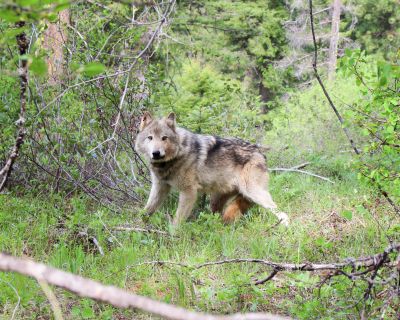Washington wolf population declines slightly for first time in 16 years

Washington’s wolf numbers shrank slightly last year for the first time in 16 years.
The Department of Fish and Wildlife’s 2024 Wolf Conservation and Management Report put the year-end minimum count for 2024 at 230 wolves, a roughly 9% drop from 2023. The number of successful breeding pairs also dropped.
That breaks a longstanding trend of annual growth in the population. The number of breeding pairs across the state also dropped from 24 to 18.
Ben Maletzke, WDFW’s statewide wolf specialist, presented the report to the Washington Fish and Wildlife Commission on Saturday. He said the 37 wolf deaths the agency documented last year wasn’t significantly higher than recent years, but that the seven illegally killed wolves are concerning.
Some of those killings took place in the southern portion of the Cascade Range, a place where just a handful of wolves have been documented in recent years.
In this year’s report, biologists did not find any wolves in that part of the range.
“The wolves we’ve known about have all been unlawfully harvested in the south Cascades,” Maletzke said.
Gray wolves were first rediscovered in Washington in 2008 after being virtually nonexistent for decades. Since resurfacing, the population has enjoyed high growth rates, averaging about 20% a year.
The high mark last year was a minimum count of 254, which WDFW amended down from 260 this week due to a counting error.
Washington’s wolves are protected under the federal Endangered Species Act in the western two-thirds of the state. They are delisted in the eastern third, but still protected as endangered under state law.
WDFW staff recommended the commission last year to reduce state-level protections for the wolves but commissioners declined to reduce protections. The decision irked livestock producers and local law enforcement officials in northeastern Washington who feel there are too many wolves.
Some wolf advocates see the report released Saturday as a sign that the commission made the right call. Francisco Santiago-Avila, the science and advocacy director for Washington Wildlife First, said in a statement that the report “underscores the continued fragility of Washington’s wolf population and the persistent challenges we face in reaching state recovery goals.”
Despite the overall decline this year, WDFW recorded an increase in the number of wolf packs, from 42 to 43. That’s the product of the dissolution of two packs in the eastern part of the state and the addition of three in the North Cascades.
Maletzke said that shows that the population in the eastern region – including both the Blue Mountains and the northeastern corner – is starting to stabilize a bit and that the North Cascades population is on the rise.
“It’s promising that we’re seeing that growth in the North Cascades,” he said.
The bulk of the population is still in the northeast, however.
It was an especially busy year for wolf-livestock conflict. A total of 55 cattle were either injured or killed by wolves, as was one domestic dog.
Maletzke said those incidents involved at most 10 of the 43 wolfpacks, meaning 77% of the state’s wolves had no run-ins with livestock.
WDFW killed four wolves from two packs in response to repeated cattle attacks.
Idaho estimated its wolf population at about 1,150 in 2023, according to the state Department of Fish and Game.